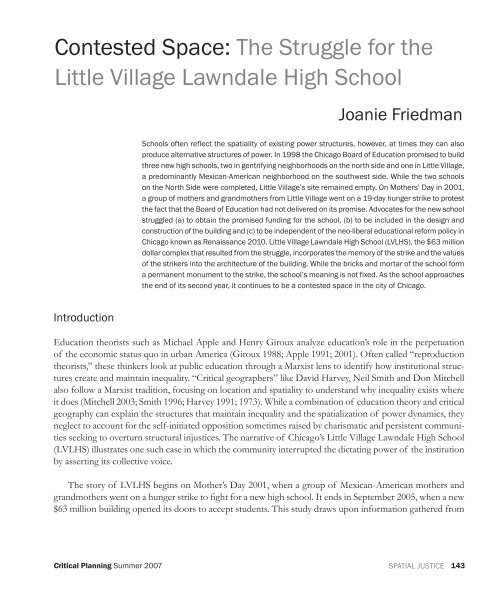158 Critical Planning Summer 2006 Critical Planning Summer 2007 ...
158 Critical Planning Summer 2006 Critical Planning Summer 2007 ...
158 Critical Planning Summer 2006 Critical Planning Summer 2007 ...
Create successful ePaper yourself
Turn your PDF publications into a flip-book with our unique Google optimized e-Paper software.
Contested Space: The Struggle for theLittle Village Lawndale High SchoolJoanie FriedmanSchools often reflect the spatiality of existing power structures, however, at times they can alsoproduce alternative structures of power. In 1998 the Chicago Board of Education promised to buildthree new high schools, two in gentrifying neighborhoods on the north side and one in Little Village,a predominantly Mexican-American neighborhood on the southwest side. While the two schoolson the North Side were completed, Little Village’s site remained empty. On Mothers’ Day in 2001,a group of mothers and grandmothers from Little Village went on a 19-day hunger strike to protestthe fact that the Board of Education had not delivered on its promise. Advocates for the new schoolstruggled (a) to obtain the promised funding for the school, (b) to be included in the design andconstruction of the building and (c) to be independent of the neo-liberal educational reform policy inChicago known as Renaissance 2010. Little Village Lawndale High School (LVLHS), the $63 milliondollar complex that resulted from the struggle, incorporates the memory of the strike and the valuesof the strikers into the architecture of the building. While the bricks and mortar of the school forma permanent monument to the strike, the school’s meaning is not fixed. As the school approachesthe end of its second year, it continues to be a contested space in the city of Chicago.IntroductionEducation theorists such as Michael Apple and Henry Giroux analyze education’s role in the perpetuationof the economic status quo in urban America (Giroux 1988; Apple 1991; 2001). Often called “reproductiontheorists,” these thinkers look at public education through a Marxist lens to identify how institutional structurescreate and maintain inequality. “<strong>Critical</strong> geographers” like David Harvey, Neil Smith and Don Mitchellalso follow a Marxist tradition, focusing on location and spatiality to understand why inequality exists whereit does (Mitchell 2003; Smith 1996; Harvey 1991; 1973). While a combination of education theory and criticalgeography can explain the structures that maintain inequality and the spatialization of power dynamics, theyneglect to account for the self-initiated opposition sometimes raised by charismatic and persistent communitiesseeking to overturn structural injustices. The narrative of Chicago’s Little Village Lawndale High School(LVLHS) illustrates one such case in which the community interrupted the dictating power of the institutionby asserting its collective voice.The story of LVLHS begins on Mother’s Day 2001, when a group of Mexican-American mothers andgrandmothers went on a hunger strike to fight for a new high school. It ends in September 2005, when a new$63 million building opened its doors to accept students. This study draws upon information gathered from<strong>Critical</strong> <strong>Planning</strong> <strong>Summer</strong> <strong>2007</strong> SPATIAL JUSTICE 143


